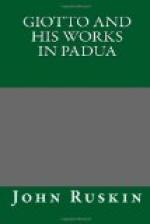We moderns, educated in reality far more under the influence of the Dutch masters than the Italian, and taught to look for realisation in all things, have been in the habit of casting scorn on these early Italian works, as if their simplicity were the result of ignorance merely. When we know a little more of art in general, we shall begin to suspect that a man of Giotto’s power of mind did not altogether suppose his clusters of formal trees, or diminutive masses of architecture, to be perfect representations of the woods of Judea, or of the streets of Jerusalem: we shall begin to understand that there is a symbolical art which addresses the imagination, as well as a realist art which supersedes it; and that the powers of contemplation and conception which could be satisfied or excited by these simple types of natural things, were infinitely more majestic than those which are so dependent on the completeness of what is presented to them as to be paralysed by an error in perspective, or stifled by the absence of atmosphere.
Nor is the healthy simplicity of the period less marked in the selection than in the treatment of subjects. It has in these days become necessary for the painter who desires popularity to accumulate on his canvas whatever is startling in aspect or emotion, and to drain, even to exhaustion, the vulgar sources of the pathetic. Modern sentiment, at once feverish and feeble, remains unawakened except by the violences of gaiety or gloom; and the eye refuses to pause, except when it is tempted by the luxury of beauty, or fascinated by the excitement of terror. It ought not, therefore, to be without a respectful admiration that we find the masters of the fourteenth century dwelling on moments of the most subdued and tender feeling, and leaving the spectator to trace the under-currents of thought which link them with future events of mightier interest, and fill with a prophetic power and mystery scenes in themselves so simple as the meeting of a master with his herdsmen among the hills, or the return of a betrothed virgin to her house.
[Illustration]
It is, however, to be remembered that this quietness in character of subject was much more possible to an early painter, owing to the connection in which his works were to be seen. A modern picture, isolated and portable, must rest all its claims to attention on its own actual subject: but the pictures of the early masters were nearly always parts of a consecutive and stable series, in which many were subdued, like the connecting passages of a prolonged poem, in order to enhance the value or meaning of others. The arrangement of the subjects in the Arena Chapel is in this respect peculiarly skilful; and to that arrangement we must now direct our attention.
[Illustration: INTERIOR OF THE ARENA CHAPEL, PADUA, LOOKING EASTWARD.]




